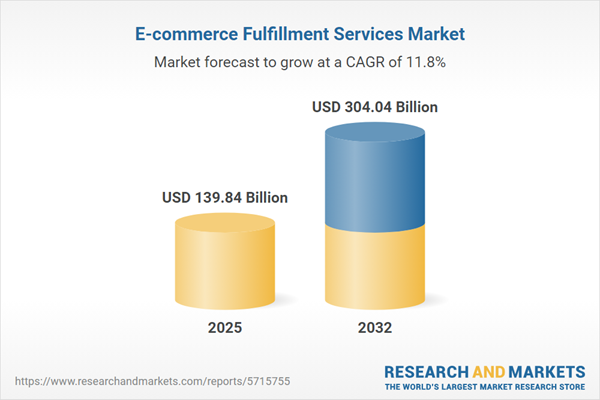Speak directly to the analyst to clarify any post sales queries you may have.
The e-commerce fulfillment services market is rapidly evolving, enabling businesses to deliver faster, more reliable, and customer-centric solutions across global markets. Innovation, complex supply chains, and regulatory shifts are key factors influencing competitive positioning for senior decision-makers seeking sustained growth in this space.
Market Snapshot: Growth Trends and Future Potential in E-Commerce Fulfillment Services
The E-commerce Fulfillment Services Market grew from USD 124.97 billion in 2024 to USD 139.84 billion in 2025. It is expected to continue growing at a CAGR of 11.75%, reaching USD 304.04 billion by 2032. This expansion is driven by accelerations in online retail adoption, heightened consumer expectations, and ongoing innovation in fulfillment and delivery technologies.
Scope & Segmentation of the E-Commerce Fulfillment Services Market
This analysis provides a detailed breakdown of core segments, operational models, and technological adoption, supporting leaders in identifying the right strategic direction:
- Service Models: In-house fulfillment, third-party fulfillment (asset-based logistics, non-asset-based logistics)
- Channel Types: B2B (direct contracts, wholesale distribution), B2C (company webstores, online marketplaces), D2C
- Delivery Modes: Express delivery, same day delivery, standard delivery
- Order Volume: High, medium, low
- End Use Industries: Automotive, electronics, food and beverage, healthcare (medical equipment, pharma), retail (apparel and accessories, electronics retail, grocery and food)
- Customer Size: Large enterprises, small and medium enterprises (medium, micro, small)
- Automation Level: Fully automated, manual, semi-automated solutions
- Pricing Models: Hybrid, pay as you go, subscription
- Geographies: Americas (United States, Canada, Mexico, Brazil, Argentina, Chile, Colombia, Peru), Europe (United Kingdom, Germany, France, Russia, Italy, Spain, Netherlands, Sweden, Poland, Switzerland), Middle East (UAE, Saudi Arabia, Qatar, Turkey, Israel), Africa (South Africa, Nigeria, Egypt, Kenya), Asia-Pacific (China, India, Japan, Australia, South Korea, Indonesia, Thailand, Malaysia, Singapore, Taiwan)
- Key Players: Amazon.com, Deutsche Post AG, United Parcel Service, FedEx Corporation, Kuehne + Nagel International, GXO Logistics, XPO Logistics, SF Holding, JD Logistics, C.H. Robinson Worldwide
Key Takeaways for Senior Decision-Makers
- Technology adoption, such as next-generation robotics and AI, is transforming distribution centers from traditional warehouses into agile fulfillment hubs.
- Collaboration across retail, logistics, and technology providers accelerates the deployment of innovative models like micro-fulfillment and localized inventory networks.
- Channel and customer segmentation enables tailored offerings, improving cost efficiency and service quality based on order volume, industry, and enterprise size.
- Operational visibility and data-driven decision-making, powered by unified analytics platforms, enhance forecasting, inventory management, and agility.
- Strategic partnerships and M&A drive end-to-end integration, expanding geographic reach and digital capability within an increasingly competitive and dynamic market.
Tariff Impact: Implications of Policy Shifts on E-Commerce Fulfillment
Recent U.S. tariffs on consumer products are increasing cost volatility for cross-border operations. In response, organizations are optimizing sourcing strategies, re-negotiating logistics contracts, and incorporating advanced scenario planning tools to manage duty exposure. Digital customs clearance and real-time compliance automation support efficient import flows, helping maintain high service levels and cost control amid regulatory uncertainty.
Methodology & Data Sources
This report uses a rigorous methodology combining extensive secondary research—company filings, government releases, industry white papers—with structured interviews from senior leaders in logistics, retail, and technology. Quantitative data is drawn from proprietary databases and validated through executive insights and case studies. SWOT, PESTLE, and Porter’s Five Forces frameworks underpin the analysis, reviewed by independent experts for accuracy.
Why This Report Matters: Enabling Strategic Advantage in E-Commerce Fulfillment Services
- Enhance executive decision-making with in-depth, actionable perspectives on emerging fulfillment technologies and market dynamics.
- Benchmark against global and regional leaders to strategically position operations, investment, and expansion strategies.
- Navigate evolving regulatory, geopolitical, and consumer trends with clear, segmented analysis and tailored recommendations for resilience and growth.
Conclusion
The e-commerce fulfillment services market continues to be reshaped by evolving technologies, regulatory shifts, and changing consumer expectations. Leaders equipped with timely intelligence and robust segmentation insights are best positioned to execute agile strategies that ensure sustained competitive advantage.
Additional Product Information:
- Purchase of this report includes 1 year online access with quarterly updates.
- This report can be updated on request. Please contact our Customer Experience team using the Ask a Question widget on our website.
Table of Contents
3. Executive Summary
4. Market Overview
7. Cumulative Impact of Artificial Intelligence 2025
Companies Mentioned
The companies profiled in this E-commerce Fulfillment Services market report include:- Amazon.com, Inc.
- Deutsche Post AG
- United Parcel Service, Inc.
- FedEx Corporation
- Kuehne + Nagel International AG
- GXO Logistics, Inc.
- XPO Logistics, Inc.
- SF Holding Co., Ltd.
- JD Logistics, Inc.
- C.H. Robinson Worldwide, Inc.
Table Information
| Report Attribute | Details |
|---|---|
| No. of Pages | 183 |
| Published | November 2025 |
| Forecast Period | 2025 - 2032 |
| Estimated Market Value ( USD | $ 139.84 Billion |
| Forecasted Market Value ( USD | $ 304.04 Billion |
| Compound Annual Growth Rate | 11.7% |
| Regions Covered | Global |
| No. of Companies Mentioned | 11 |









